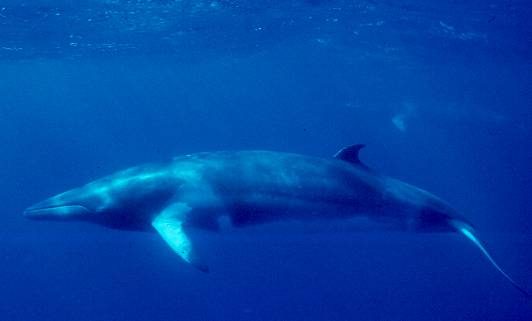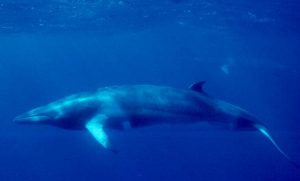Minke Whale Genetics show Adaptations for Diving
By Jessica Wingar, RJD Intern
Minke whales, Balaenoptera acutorostrata, may not be the largest baleen whale, but they are the most abundant. These whales are about thirty five feet long, 6500kg, and are black with a white stomach (Knox, G.A., 2007). This species of whale is said to be a cosmopolitan species, since they are found in many different climates of the world. Although these whales are abundant, one of their main threats is overexploitation in fisheries. In places, such as the North Pacific, their populations have been fished so much that the International Whaling Commission, the IWC, has them listed as of concern. Overfishing is not the only threat to minke whales. They are also threatened by noise, vessel strikes, and habitat disturbance. (Minke Whale, 2014).
Like many other marine mammals, minke whales have multiple techniques to catch their prey. Minke whales feed on a variety of food. These varieties are crustaceans, plankton, and small schooling fish. In order to eat some of these food types they must dive. This species can dive for up to fifteen minutes at a time. Some of the techniques that they use while diving include landing on their side on top of the prey and ingesting a significant amount of water while feeding. By side lunging they can stun their prey and by gulping a lot of water they can collect a lot of plankton that they can then sift through (Minke Whale, 2014). Once they have the food, minke whales then swallow their food whole (Know, G.A., 2007). Diving for their prey requires a lot of adaptations.
When a whale dives, a lot of changes occur internally. There are three steps that occur when marine mammals hold their breath. The first step is called hypoxia, which is the decrease in oxygen in the whale’s body. The second step is hypercapnia when the body experiences an increase in carbon dioxide. And the final step occurs when there is a build up of lactic acid in the body. All of these stages add up and prevent the animal from suffocating because they tell the body that it needs air. Thus, the whale then returns to the surface to breathe (Richardson, 2013). One of the main behaviors of minke whales is diving, and a recent study on their genetics shows how their genes are adapted for this behavior.
Minke whales provide a good specimen for genome sequencing because they are such a widely distributed marine mammal. This study is the first of its kind to complete a high depth genetic analysis of a marine mammal. From the study, the researchers found that there were many whale specific genes. One of the most interesting gene that was found to be expanded in minke whales was the peroxiredoxin (PRDX) family. This family is related with stress resistance. The fact that this gene family is expanded could show that these animals are prone to stress, whether from humans or from diving, and have evolved to have more stress combating genes. Another interesting finding also involved their diving physiology. O-linked N-acetylglucasominylation in many proteins has been found to multiply the response to stress. Stress occurs when a minke whale dives and experiences hypoxia. In minke whales, this gene is expanded three times. This gene is just an example of one of the many genes they found expanded that are related to dealing with hypoxia. In addition, as mentioned above, lactate can build up in the body after prolonged diving. The researchers found that the enzyme, lactate dehydrogenase, which converts pyruvate to lactate to be expanded in animals, such as minke whales. Therefore, many different objects in the minke whale genome have expanded in order to account for the behaviors most exhibited by this animal. This study was very ground breaking and will lead the way for many other marine mammal genomes to be completely sequenced (Yim, H et al, 2014).
Knox, G. (2007). Biology of the southern ocean. (2nd ed.). Boca Raton, FL: CRC Press.
Minke whale. (2014, January 09). Retrieved from http://www.nmfs.noaa.gov/pr/species/mammals/cetaceans/minkewhale.htm
Richardson, Jill. “Anatomy and Physiology Part II.” MSC 350. University of Miami, Coral Gables. Mar. 2013. Lecture.
Yim, H, Cho, Y.S., Guang, X, Kang, S.G., Jeong, J, Cha, s, Oh, H, Lee, J, Yang, E.C., Kwon, K. K., Kim, Y.J., Kim, T.W., Kim, W, Jeon, J.H., Kim, S, Choi, D.H., Jho, S, Kim, H, Ko, J, Kim, H, Shin, Y, Jung, H, Zheng, Y, Wang, Z, Chen, Y, Chen, M, Jiang, A, Li, E, Zhang, S, Hou, H, Kim, T.H., Yu, L, Liu, S, Ahn, K, Cooper, J, Park, S, Hong, C.P., Jin, W, Kim, H, Park, C, Lee, K, Chun, S, Morin, P.A., O’Brien, S.J., Lee, H, Kimura, J, Moon, D.Y., Manica, A, Edwards, J, Kim, B.C., Kim, S, Wang, J, Bhak, J, Lee, H.S. and Lee, J. 2014. Minke whale genome and aquatic adaptation in cetaceans. Nature Genetics, 46 (1): 88-94.






Leave a Reply
Want to join the discussion?Feel free to contribute!